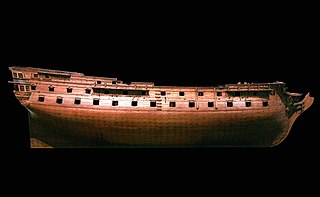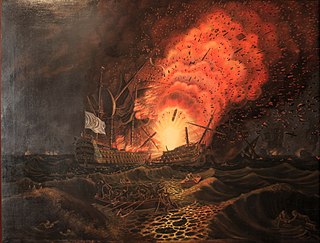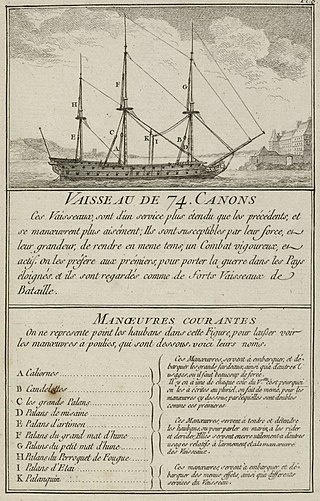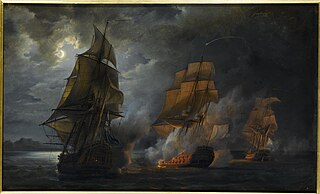
HMS Ardent was a 64-gun third-rate ship of the line of the Royal Navy. She was built by contract at Blaydes Yard in Hull according to a design by Sir Thomas Slade, and launched on 13 August 1764 as the first ship of the Ardent-class. She had a somewhat turbulent career, being captured by the French in the action of 17 August 1779, and then re-captured by Britain in 1782.

Protecteur was a Souverain-class 74-gun ship of the line of the French Navy, the only to have borne the name.
Solitaire was a 64-gun ship of the line of the French Navy, built by Antoine Groignard and launched in 1774, lead ship of her class. She was captured by the Royal Navy on 6 December 1782, and commissioned as the third rate HMS Solitaire. She was sold out of the Navy in 1790.

Surveillante was an Iphigénie-class 32-gun frigate of the French Navy. She took part in the Naval operations in the American Revolutionary War, where she became famous for her battle with HMS Quebec; in 1783, she brought the news that the war was over to America. She later took part in the French Revolutionary Wars, and was eventually scuttled during the Expédition d'Irlande after sustaining severe damage in a storm. The wreck was found in 1979 and is now a memorial.

Neptune was a 74-gun ship of the line of the French Navy.
The Zélé was a 74-gun ship of the line of the French Royal Navy. She was funded by a don des vaisseaux donation from the Régisseur général des finances.

The Conquérant was originally designed and built by François Coulomb the Younger at Toulon from 1745 to 1747, as a modified version of the same constructor's Terrible built at the same dockyard in 1736-40. In need of major repairs by early 1755, she was not employed throughout the Seven Years' War, after which she was formally taken out of service on 17 March 1764 and was rebuilt by Joseph-Louis Ollivier at Brest from January to December 1765 as a Citoyen-class 74-gun ship of the line of the French Navy.

The Vengeur was a 64-gun ship of the line of the French Navy designed by Antoine Groignard. She saw action with Bailli de Suffren during the American War of Independence.

The Magnanime was a 74-gun of the French Navy, lead ship of her class.

César was a 74-gun ship of the French Navy. Ordered in the spring of 1767 from the Toulon shipyard, she was launched on 3 August 1768. César saw service in the American War of Independence, during which she was destroyed in the Battle of the Saintes.

Hector was a 74-gun ship of the line of the French Navy, lead ship of her class. Hector was launched in 1755 and fought in the American Revolutionary War during which she captured two ships of the British Royal Navy on 14 August 1778. In 1782, the ship was captured by the Royal Navy at the Battle of the Saintes in 1782. Taken into service by the Royal Navy, the vessel was renamed HMS Hector. On 5 September 1782. HMS Hector fought two French frigates. Severely damaged during the battle, and by a hurricane that followed later in September, Hector sank on 4 October 1782.
The Citoyen was a 74-gun ship of the line of the French Navy, lead ship of her class to a design by Joseph-Louis Ollivier. She was funded by a don des vaisseaux donation from the Bankers and General Treasurers of the Army.

Palmier was a 74-gun ship of the line of the French Navy.

Robuste was an 74-gun ship of the line of the French Navy, built by Antoine Groignard.

Éveillé was an Artésien-class 64-gun ship of the line of the French Navy, launched in 1772.

Pierre de Roquefeuil-Montpeyroux was a French Navy officer. He served during the War of American Independence.
Louis Augustin de Monteclerc was a French Navy officer. He served in the War of American Independence.

Triton was a 64-gun ship of the line of the French Navy designed by François Coulomb the Younger. She took part in the Seven Years' War and in the War of American Independence.
Zodiaque was a 74-gun Diadème-class ship of the line of the French Navy.

Armand-Claude Poute de Nieuil was a French Navy officer. He served during the War of American Independence.














